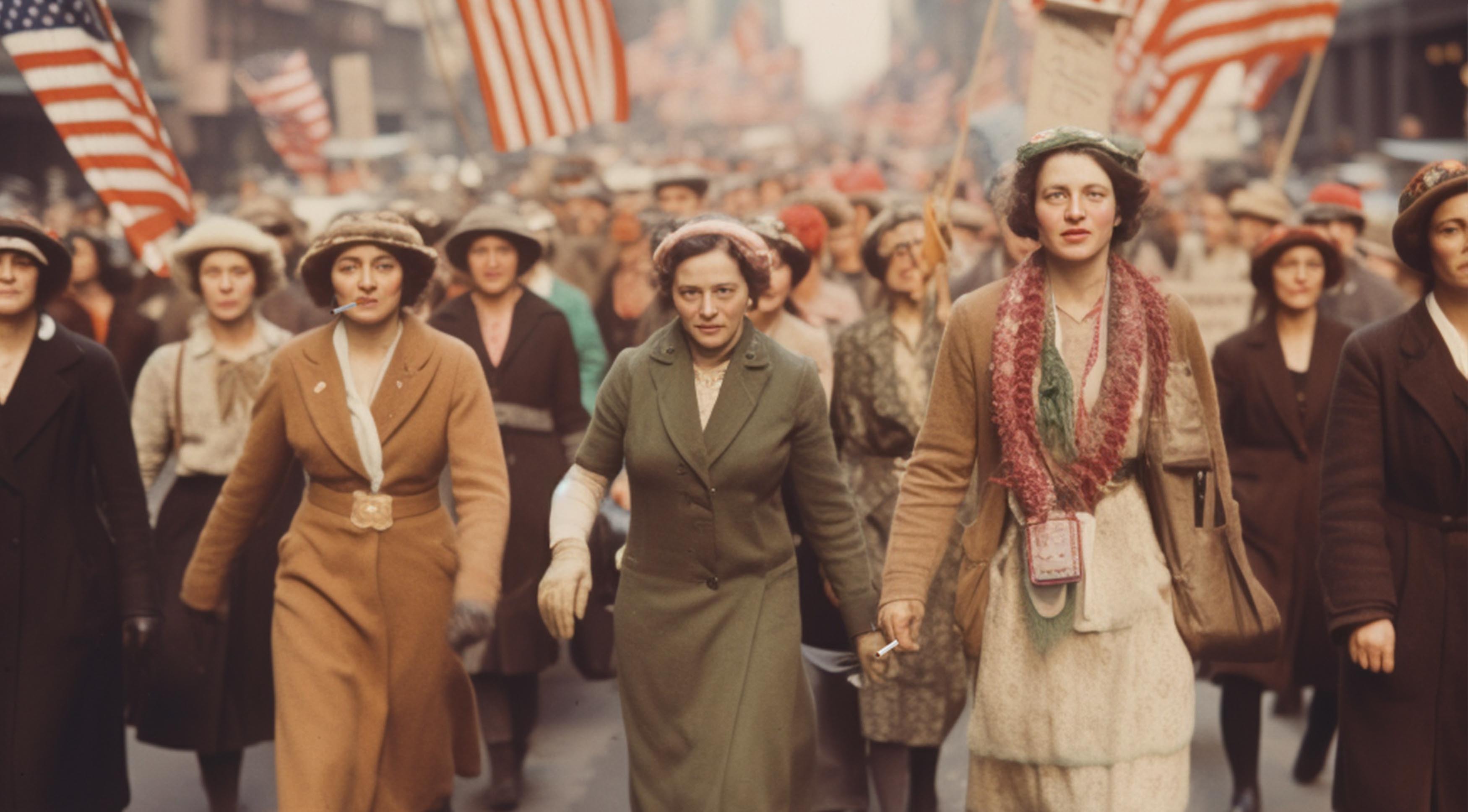Torches of Freedom: Women’s Right to Smoke Cigarettes
One of the many marches for Women’s Rights through the years has been somewhat forgotten by history: The right to smoke cigarettes. In the 1920s, there was a push-back against the societal and legal taboo of women smoking in public. The “Torches of Freedom” march aimed to reverse that. In this episode, we tell the story about the movement and then play the quick quiz with Comedian and frequent guest of the show, Lisa Berry!

It wasn’t until the 1960s that America started running anti-smoking campaigns on television. They were aired as part of the Fairness Doctrine. For every cigarette ad, the FCC required that television stations also run one anti-smoking ad. These were usually made with the support of the American Heart or Lung Associations.
Until then, smoking was such a part of the American culture that almost half of all American adults smoked cigarettes. And of American smokers, only about 30% of them were women. This huge gender disparity in tobacco use continued until around the mid 90s, when that gap became smaller. Most cigarette ads were geared toward men, but occasionally, tobacco brands would try to appeal to both men and women.
But our story begins long before the 1960s, and has to do with the reason that huge disparity between men and women smokers.
As far back as I could find, it was taboo for women in Western society to smoke. There were a few exceptions to this. For example, I found newspaper articles from 1880 describing to Americans how Italian women smoked. It was used to describe how different life was in Italy. Likewise, smoking was one of the things that was pointed to when an article was written talking about how barbaric and unrefined Native Americans in New Mexico were. This is from an 1880 newspaper describing the Navajos:
“The women smoke cigarettes, making them as they use them. The morals are as bad as well can be. A majority of their priests lived in open prostitution.” It goes on like this, but its interesting to see how tobacco use was linked to morality here. In the late 19th century and early 20th century, smoking among females was seen as a sign of loose morals and was often included in the same thought as prostitution and promiscuity.
There are examples in 19th century art that depict females smoking cigarettes and in many instances, this is used to convey a sense of rebellion, promiscuity and personal empowerment. But there are also examples of art – like in Dutch Paintings – where a female holding a cigarette is meant to be a sign of foolishness. There are newspaper articles citing Americans traveling to Europe and being completely aghast at women smoking openly in public.
Meanwhile back in America, there were places where women could actually be arrested for smoking in public. I found this newspaper entry from 1880. “In Providence, R.I., two girls were recently arrested for smoking in the streets while young America can strut forth with cigarette or full cigar and pass along like locomotives emitting a cloud of smoke, and can do so with impunity. This is rank injustice. It is quite as proper for a young miss as it is for a young master to be caught tugging away at a cigar, and if the law is to assert its majesty in one case, it should in the other. No boy should be allowed the use of tobacco before he attains his majority any more than a girl of a like age.”
So that was a rather progressive sentiment for the time. Lots of cities were passing anti-smoking laws that just applied to women. In 1904, a woman named Jannie Lasher was thrown in jail for smoking around her children. She was kept for 30 days in a Philadelphia jail. At that time, it was illegal for women to smoke in the presence of their family. In 1908, New York City voted to ban women from smoking in public. There were literally orders given to New York City police to arrest any proprietor or manager of a hotel, bar, cabaret or other public establishment that allowed women to smoke. Of course men could smoke wherever and whenever they wanted.
By 1929, there was enough push back on these uneven laws that women finally started to gather and march. So in the Easter Parade on March 31st of that year, a group of women marched together under the name “Torches of Freedom” in New York City. Women weren’t just fighting for smoking. They were fighting against unfair and uneven application of the law. They saw smoking cigarettes as a form of freedom and these smoking bans that only applied to women were limiting their freedom. So they marched with cigarettes in hand, carrying banners promoting gender equality and the right for them to smoke where and when they wanted to.
It wasn’t just New York City. Similar Torches of Freedom marches happened in Boston, Detroit and San Fransisco.The marches caught the eyes of much of the national press and showed up in newspapers nationwide. The movement was being taken seriously and the public took note.
It sounds strange to give you this next statistic as a positive. But in 1923, only 5% of the cigarettes sold in the U.S. were smoked by women. After Torches of Freedom, that number shot up to 12%, then to 18% in the next ten years and just kept rising until the 1970s. The legislative efforts to ban women from smoking in different cities or states failed.
So the Torches of Freedom campaign was a success from the standpoint of opposing anti-smoking laws for women, but was it really a grassroots movement? The answer is no.
Let’s talk about a guy named Edward Bernays. In his 1923 book “Crystallizing Public Opinion,” he writes: “The only difference between “propaganda” and “education,” really, is in the point of view. The advocacy of what we believe in is education. The advocacy of what we don’t believe in is propaganda. Each of these nouns carries with it social and moral implications. Education is valuable, commendable, enlightening, instructive. Propaganda is insidious, dishonest, underhand, misleading.”
And it’s important to note at this point, that Bernays’s work was largely in the area of propaganda. He had worked for a Medical Review Publication that took positions such as promoting the health benefits of taking showers and the harmful effects of wearing corsets. He dabbled in the world of being a press agent for theater productions and set up a Vaudeville Pancake Breakfast to help Calvin Coolidge become more likable for his 1924 Presidential Campaign. In 1927, he was working with a small tobacco manufacturer to help them compete against the popular Lucky Strike brand of cigarettes, owned by The American Tobacco Company. The American Tobacco Company took note and hired Bernays to come work for them instead.
Their number one goal at the time was to increase smoking among populations that hadn’t really taken it up. The largest demographic that was largely untapped was American women. In order to come up with a plan for marketing cigarettes to women, he worked with Abraham Brill, who was a psychoanalyst. Together, they developed the Torches of Freedom idea – the idea that cigarettes represented freedom for women whose desires were being oppressed.
He outlined the plan to recruit women to march for this cause, approaching local churches and finding several women at each church to march and protest for Torches of Freedom. He was very specific about the kind of woman he wanted, too. He didn’t want models or actresses or anyone that looked like they were trying to sell something. He wanted what he considered to be normal looking everyday women. Women who already supported women’s freedom causes would be best. And he started spreading the message.
Bernays himself hid behind these women. Even in communicating and organizing with them, he always used other people as go-betweens. He knew that for the operation to succeed, the public must believe that it was a grass roots movement. So Easter parades all over the country had small delegations of convinced women marching for his cause. He had his people arrange publicity photos and press releases to accompany these marches and the result was that hundreds of newspapers around America ran stories about how these industrious young women were marching for their rights to smoke cigarettes just like men.
So the movement was what’s known as an “astroturf” movement. Meant to look like a real grass-roots effort, but sponsored by some secret back channel – in this case, the American Tobacco Company.
This really opened a door for Lucky Strike to start advertising heavily toward women. They used ideas like promoting cigarettes as a form of weight loss. Instead of snacking, they would say, why not smoke a cigarette after dinner? They promoted being skinny as a beauty standard, and sold the idea that cigarettes were a way to achieve that beauty.
Almost instantly, cigarette use by women shot up by 400%. The money paid to their propagandist was paying off. Year by year, more and more women began smoking all the way up until smoking peaked in 1977.
As we know, the late 1990s and early 2000s saw more and more research that reached the public explaining the dangers of smoking and thankfully, we’re finally seeing a healthier population as a result. The numbers of throat and lung cancer and heart disease due to cigarettes have dropped rapidly and continue to drop by as much as 5% per year.
So while the Torches for Freedom campaign never really gave anyone real freedom – Not in the truest sense of the word, it was an example of women fighting against unfair laws about what they can and can’t do with their bodies. So in that way, maybe there are some parallels to modern day. But the whole Torches of Freedom thing was a money grab – a way for cigarette manufacturers to further expand their market by using women as pawns. So whether you smoke or you know someone who does, next time you see someone on their smoke break, you now have an interesting piece of trivia to bring up. The Internet Says it’s True.

Bonus episodes and content available at http://Patreon.com/MichaelKent
Review this podcast at https://podcasts.apple.com/us/podcast/the-internet-says-it-s-true/id1530853589
For special discounts and links to our sponsors, visit http://theinternetsaysitstrue.com/deals

